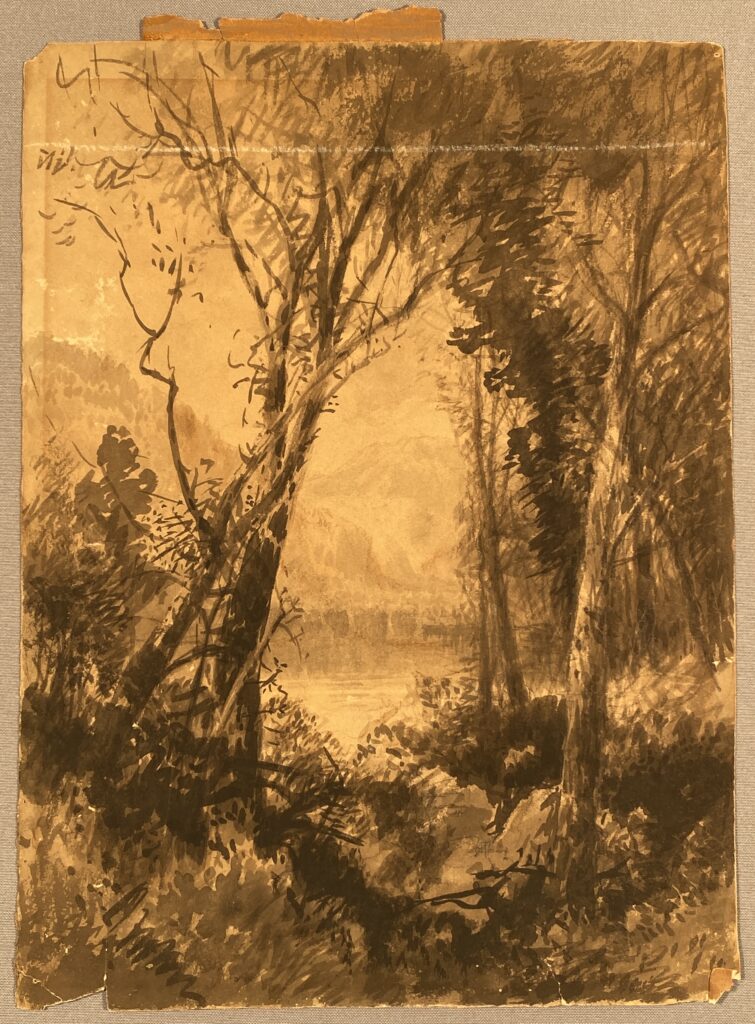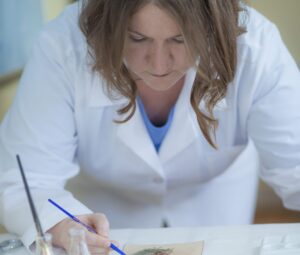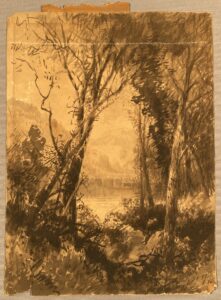Focus Keywords: William Hart, Conservation Treatment, Paintings, Hudson River School
We recently completed conservation treatment of a collection of paintings by William Hart. William Hart was a prominent 19th-century American landscape painter associated with the Hudson River School, a group of artists known for their romantic and naturalistic depictions of the American wilderness.
The collection of artwork included watercolors, a drawing, and a lithograph print.

Watercolor painting by William Hart, prior to conservation treatment.

A watercolor painting by William Hart, after conservation treatment.
Treatment involved surface cleaning, washing the artworks to reduce staining and discoloration, and deacidifying the paper to provide an alkaline reserve. The watercolor above had particularly soluble media, so great care had to be taken to protect the watercolor pigments during wet treatment. Washing watercolors and hand colored lithographs requires extensive evaluation and testing prior to treatment in order to determine the safest and most effective approach to reduce staining and discoloration while protecting the media. The lithograph below contained hand colored elements that were thickly applied, with minimal binder present. The minimal presence of a binder meant that he hand colored elements were extremely soluble, so great care and precautionary measures were taken prior and during treatment to protect the media.

Lithograph by William Hart, before conservation treatment. Foxing was evident throughout.

A hand colored lithograph by William Hart after to conservation treatment which involved washing and stain reduction.

A drawing by William Hart prior to conservation treatment. Condition issues included acidity, staining, and discoloration.

Drawing by William Hart after conservation treatment. Treatment included washing, stain reduction, tape removal and archival lining.
Focus Keywords: William Hart Biography, Fine Art, Decorative Painting, Old Masters, Lithography
Born in Paisley, Scotland, in 1823, Hart immigrated with his family to the United States in 1831, settling in Albany, New York. His early experiences growing up in a new and rapidly expanding country shaped his appreciation for the American landscape and influenced his later artistic work. Hart began his career not as a painter, but as an apprentice to a decorative painter, learning to paint coaches and signs. These early jobs provided him with technical skills and an understanding of color, composition, and detail. Eventually, Hart’s passion for fine art grew, and he shifted his focus toward landscape painting. He studied and worked in Albany and New York City and even traveled to Europe in the 1840s to study the works of Old Masters and to refine his technique.
Focus Keywords: Hudson River School, American Landscape, Pastoral Scenes
As Hart matured as an artist, he became a central figure in the Hudson River School, a movement that celebrated the natural beauty of the American landscape, particularly the Hudson River Valley and surrounding areas. His work was characterized by serene compositions, luminous skies, and detailed portrayals of rural scenery. He often painted pastoral scenes with cattle, still waters, and richly colored foliage. His attention to light and atmosphere gave his work a peaceful and almost spiritual quality. The collection of artwork we conserved is comprised of watercolors, a lithograph with hand colored elements, and a pencil sketch. All of the artworks reflect his interest in the wilderness and rural scenery.
Hart’s art was widely exhibited during his lifetime, and he earned recognition as a leading landscape painter of his day. He became a member of the National Academy of Design and served as its president for a time. William Hart’s legacy continues to live on through his many paintings, which capture the grandeur and tranquility of the 19th-century American landscape.




